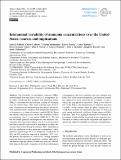Interannual variability of ammonia concentrations over the United States: sources and implications
Author(s)
Van Damme, Martin; Clarisse, Lieven; Clerbaux, Cathy; Coheur, Pierre-François; Nowak, John B.; Neuman, J. Andrew; Herndon, Scott C.; Roscioli, Joseph R.; Eilerman, Scott J.; Schiferl, Luke Daniel; Heald, Colette L.; ... Show more Show less
DownloadSchiferl-2016-Interannual variability of ammon.pdf (7.855Mb)
PUBLISHER_CC
Publisher with Creative Commons License
Creative Commons Attribution
Terms of use
Metadata
Show full item recordAbstract
The variability of atmospheric ammonia (NH[subscript3]), emitted largely from agricultural sources, is an important factor when considering how inorganic fine particulate matter (PM[subscript 2.5]) concentrations and nitrogen cycling are changing over the United States. This study combines new observations of ammonia concentration from the surface, aboard aircraft, and retrieved by satellite to both evaluate the simulation of ammonia in a chemical transport model (GEOS-Chem) and identify which processes control the variability of these concentrations over a 5-year period (2008–2012). We find that the model generally underrepresents the ammonia concentration near large source regions (by 26 % at surface sites) and fails to reproduce the extent of interannual variability observed at the surface during the summer (JJA). Variability in the base simulation surface ammonia concentration is dominated by meteorology (64 %) as compared to reductions in SO[subscript 2] and NO[subscript x] emissions imposed by regulation (32 %) over this period. Introduction of year-to-year varying ammonia emissions based on animal population, fertilizer application, and meteorologically driven volatilization does not substantially improve the model comparison with observed ammonia concentrations, and these ammonia emissions changes have little effect on the simulated ammonia concentration variability compared to those caused by the variability of meteorology and acid-precursor emissions. There is also little effect on the PM[subscript 2.5] concentration due to ammonia emissions variability in the summer when gas-phase changes are favored, but variability in wintertime emissions, as well as in early spring and late fall, will have a larger impact on PM[subscript 2.5] formation. This work highlights the need for continued improvement in both satellite-based and in situ ammonia measurements to better constrain the magnitude and impacts of spatial and temporal variability in ammonia concentrations.
Date issued
2016-09Department
Massachusetts Institute of Technology. Department of Civil and Environmental EngineeringJournal
Atmospheric Chemistry and Physics
Publisher
Copernicus GmbH
Citation
Schiferl, Luke D.; Heald, Colette L.; Van Damme, Martin; Clarisse, Lieven; Clerbaux, Cathy; Coheur, Pierre-François; Nowak, John B.; et al. “Interannual Variability of Ammonia Concentrations over the United States: Sources and Implications.” Atmospheric Chemistry and Physics 16, no. 18 (September 29, 2016): 12305–12328.© 2016 Authors
Version: Final published version
ISSN
1680-7324
1680-7316